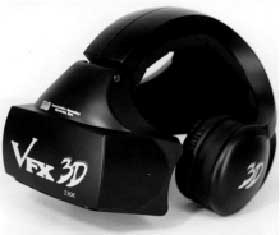
VFX-3D Head Mounted Display
USA and other western world faced consumer-focused Virtual Reality boom in late 80s and early 90s, accurately when USSR is fall apart. VR came to big industrial cities of post USSR later in 1995 – 1998, when VR hype slowly begin to fall down in USA. That was in a few years after IBM-compatible PC’s settled down in Russia, Ukraine and other countries. PC’s are finally moved aside ZX Spectrum platform which was most popular home computer in late eighties and early nineties here.
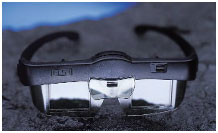
ELSA Revelator shutter-glasses
Consumer VR started with ELSA Revelator shutter glasses, Forte VFX-1, and i-Glasses HMD’s (which are still can be found from time to time in private geek collections).
These devices had much higher price here than in USA (with more than two-times higher cost), multiply this with poor level of life in after-perestroyka times, and it’s became obvious that only reach geeks were able to buy such stuff for home use, other soviet-born hackers and cyberpunks only dreamed about VR, not to mention other peoples.
According to these articles (in Russian):
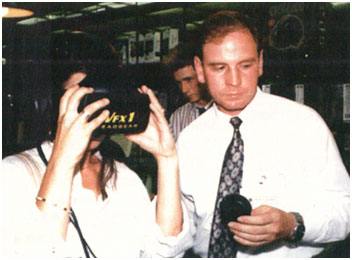
Forte VFX1 Introduction in Moscow
In 1995 Moscow company – Compulink signed contact with Forte to be exclusive reseller of VFX-1 in post-USSR countries. They settled the starting price in 1495 USD for a helmet and, as they say, in a first five days sold 25 units.
There were few attempts to make VR-arcades on base of VFX-1 helmet and some 486’s or early Pentium PC’s. Such setups were made by particular enthusiasts and placed in computer-clubs which were like modern internet-cafes but gaming-oriented. Main games played with VR were: DOOM, Heretic, Duke Nukem, Descent, Magic Carpet, Comanche-3, and later – Quake 1.
State of customer-VR at that time combined with early desktop games not always satisfied player’s expectations, and highly viable misconception was born – “VR is fun but it can hurt your eyes and your mind, and you can’t use it for serious gaming”.
Particularly we had a few of such VR arcades here in Ukraine, but they lived for a short time, and very soon they disappeared. Even newer VR hardware (like VFX-3D, P5 data gloves) and newer games didn’t save the tendency.
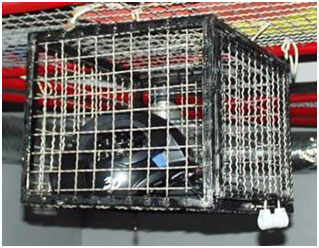
VFX-3D caged in a computer club
Virtual Reality technology at post-USSR in nineties was so unusual, rare and expensive, that only very small amount of people actually tried it. Still in our time many people here, even technically educated, think of this technology only from sci-fi point of view, not like this technology does really exists. They saw movies like “Lawnmower Man” and “Johnny Mnemonic” and that’s it, VR is only a concept from these movies for most peoples here.
Small publicity and wrong understanding of technology leads generally to ignoring of VR by scientific institutes in post-USSR countries. In opposite to western-world (USA and Europe) there were no VR labs in technical Universities, and still we don’t have any. Students of technical specialties even don’t know about VR psychological studies, 3D User Interfaces, industrial VR, or other specific threads of big scientific tree that was born by VR itself. Only realtime-graphics is widely known because game-industry context.
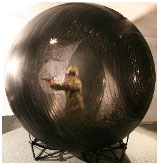
Virtusphere
However few Russian scientists were engaged with Virtual Reality in nineties, among them Ray and Nurulla Latipovs, two brothers that invented Virtusphere – VR locomotion device. Yet they were able to build device and business in USA.
Some people that get in touch with VR at earlier times found internet-communities that were intended to be VR communities (like
Really.Ru ); however they very quickly turned to communities of only stereoscopic enthusiasts. These communities recently received fresh blood with new world-wide “Avatar” 3D hype. Nowadays most popular HMD’s among VR enthusiasts of post USSR countries are eMagin Z800, new iGlasses i-3PC, Vuzix VR920, and Saibex 3D640.
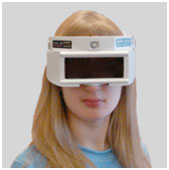
Russian manufactured panoramic shutter-glasses “Stel 3DS-GS”
Mostly, people concentrated on stereoscopy itself and prefer to buy shutter-glasses with proper monitors, or projection systems. As example of “made in Russia” tech – in early 2000 corporation Stel located at Moscow presented their stereoscopic shutter glasses with very “unusual” panoramic design named “Stel 3DS-GS”.
Funniest thing with recent 3D hype in Ukraine, is that most popular 3D tech now is seems to be anaglyph, you can buy it almost everywhere, sometimes by ridiculous prices. You can even buy red-blue conversion of classical 2D movies, such as Francis Ford Coppola’s “The Godfather”.

New Russian military helicopter stereoscopic HMD (designed for Mi-28)
Actually VR in limited aspects is used now internally in R&D of some big companies and in military purposes, but this rather exception than common rule.
Editor’s note: The authors are principals at the pioneering Ukraine VR firm VRM. The IEEE prize winning team of Maxim Lysak and Viktor Kuropyatnik specialize in VR, User Interfaces, and Simulation.







